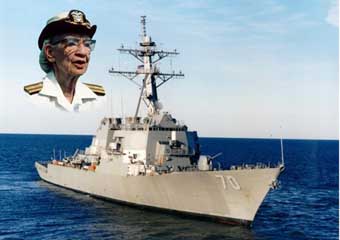Grace Murray Hopper
Rear Admiral Grace Hopper was one of the first computer programmers, pioneering concepts for computer programming languages and compilers. Her vision created the standards for the "COmputer Business Oriented Language" (COBOL) the most widely used computing language throughout most of the latter half of the twentieth century.
Admiral Hopper graduated from Vassar in 1928 with a BA in mathematics and physics, then earned her PhD in mathematics at Yale University in 1934. She was a member of the Vassar faculty from 1931-1943, at which time she joined the Naval Reserve and was assigned to the Bureau of Ordnance Computation Project . In this capacity she began working on electronic computing machines at the Cruft Laboraties at Harvard University.
In 1945 one of the Cruft Lab computers became infested with insects -- a moth in particular shorted out the computer. Dr. Hopper discovered the :"bug" in the computer and reported in the official log that she had "de-bugged" the computer -- the first ever use of the word "bug" in connection with computers. Thus a technical term entered the vernacular, and "debugging" soon came to mean removing flaws from software programs.
Following the war, Dr. Hopper returned to civilian life, joing the faculty at Harvard University. Eventually she left to become senior mathematician at the Sperry Corporoation. However, she maintained her association with the Naval Reserve and, in 1967 was recalled to active duty. She was made Director of the Navy Programming Group and devised standards and processes for validating COBOL programs. She retired as a Rear Admiral in 1986. She continued to be active in education and the industry until her death.
Dr. Hopper's husband Foster Hopper died in 1945 during World War II. They had no children and she never remarried.
The USS Hopper (DDG-70) is named in honor of Rear Admiral Grace Murray Hopper.

Born: December 9, 1906, New York City
Died: January 1, 1992, Arlington, Virginia
The premiere site for biographies of mathematicians on the web is at The University of Saint Andrews in Scotland; this is the primary source of the information in these short biographies. Some biographies used additional web resources as noted in the biography.
The postage stamp images came from a wonderful site on mathematicians on stamps maintained by Jeff Miller, a mathematics teacher in Florida.
The Free Internet Encyclopedia Wikipedia is also an excellent source of information and was used as a reference for many bographies.
The opinions expressed in these biographies are those of the author and do not reflect official views of the University of Oklahoma.
